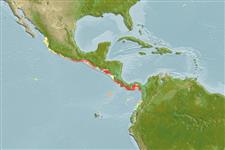>
Gobiiformes (Gobies) >
Eleotridae (Bully sleepers)
Etymology: Guavina: A name from Taíno language, cited by Las Casas: " hay otros peces que llaman guabinas, la media sílaba, breve". From the root "gua" = it, the. "There are other fishes that are named guabina, the middle syllabe, short".
More on author: Ginsburg.
Environment: milieu / climate zone / depth range / distribution range
экология
морской демерсальный. Tropical
распространение
страны | регионы FAO | Ecosystems | места находок | Point map | интродукции | Faunafri
Eastern Central Pacific.
Size / Вес / Возраст
Maturity: Lm ? range ? - ? cm
Life cycle and mating behavior
половая зрелость | размножение | нерест | икра | Fecundity | личинки
Hoese, D.F., 1995. Eleotridae. Durmientes. p. 1062-1064. In W. Fischer, F. Krupp, W. Schneider, C. Sommer, K.E. Carpenter and V. Niem (eds.) Guia FAO para Identification de Especies para lo Fines de la Pesca. Pacifico Centro-Oriental. 3 Vols. FAO, Rome. (Ref. 9296)
Статус Красного Списка МСОП (Ref. 130435: Version 2024-1)
Угроза для людей
Harmless
Использование человеком
дополнительная информация
инструменты
Специальные отчеты
Скачать в формате XML
ресурсы в Интернет
Estimates based on models
Phylogenetic diversity index (Ref.
82804): PD
50 = 0.7500 [Uniqueness, from 0.5 = low to 2.0 = high].
Bayesian length-weight: a=0.01072 (0.00393 - 0.02918), b=3.12 (2.90 - 3.34), in cm total length, based on LWR estimates for this (Sub)family-body shape (Ref.
93245).
Trophic level (Ref.
69278): 3.5 ±0.6 se; based on size and trophs of closest relatives
устойчивость к внешним воздействиям (Ref.
120179): средний (среднего размера), минимальное время удвоения популяции 1.4-4.4 года (Preliminary K or Fecundity.).
Fishing Vulnerability (Ref.
59153): Low to moderate vulnerability (27 of 100).
